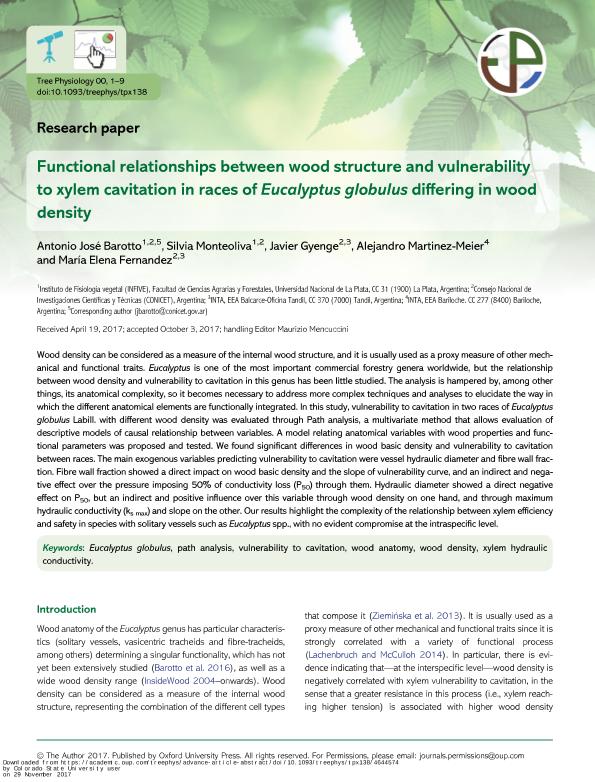Artículo
Functional relationships between wood structure and vulnerability to xylem cavitation in races of Eucalyptus globulus differing in wood density
Barotto, Antonio José ; Monteoliva, Silvia Estela
; Monteoliva, Silvia Estela ; Gyenge, Javier Enrique
; Gyenge, Javier Enrique ; Martinez Meier, Alejandro; Fernandez, Maria Elena
; Martinez Meier, Alejandro; Fernandez, Maria Elena
 ; Monteoliva, Silvia Estela
; Monteoliva, Silvia Estela ; Gyenge, Javier Enrique
; Gyenge, Javier Enrique ; Martinez Meier, Alejandro; Fernandez, Maria Elena
; Martinez Meier, Alejandro; Fernandez, Maria Elena
Fecha de publicación:
02/2018
Editorial:
Oxford University Press
Revista:
Tree Physiology
ISSN:
0829-318X
Idioma:
Inglés
Tipo de recurso:
Artículo publicado
Clasificación temática:
Resumen
Wood density can be considered as a measure of the internal wood structure, and it is usually used as a proxy measure of other mechanical and functional traits. Eucalyptus is one of the most important commercial forestry genera worldwide, but the relationship between wood density and vulnerability to cavitation in this genus has been little studied. The analysis is hampered by, among other things, its anatomical complexity, so it becomes necessary to address more complex techniques and analyses to elucidate the way in which the different anatomical elements are functionally integrated. In this study, vulnerability to cavitation in two races of Eucalyptus globulus Labill. with different wood density was evaluated through Path analysis, a multivariate method that allows evaluation of descriptive models of causal relationship between variables. A model relating anatomical variables with wood properties and functional parameters was proposed and tested. We found significant differences in wood basic density and vulnerability to cavitation between races. The main exogenous variables predicting vulnerability to cavitation were vessel hydraulic diameter and fibre wall fraction. Fibre wall fraction showed a direct impact on wood basic density and the slope of vulnerability curve, and an indirect and negative effect over the pressure imposing 50% of conductivity loss (P 50) through them. Hydraulic diameter showed a direct negative effect on P 50, but an indirect and positive influence over this variable through wood density on one hand, and through maximum hydraulic conductivity (k s max) and slope on the other. Our results highlight the complexity of the relationship between xylem efficiency and safety in species with solitary vessels such as Eucalyptus spp., with no evident compromise at the intraspecific level.
Archivos asociados
Licencia
Identificadores
Colecciones
Articulos(CCT - MAR DEL PLATA)
Articulos de CTRO.CIENTIFICO TECNOL.CONICET - MAR DEL PLATA
Articulos de CTRO.CIENTIFICO TECNOL.CONICET - MAR DEL PLATA
Articulos(INFIVE)
Articulos de INST.DE FISIOLOGIA VEGETAL
Articulos de INST.DE FISIOLOGIA VEGETAL
Citación
Barotto, Antonio José; Monteoliva, Silvia Estela; Gyenge, Javier Enrique; Martinez Meier, Alejandro; Fernandez, Maria Elena; Functional relationships between wood structure and vulnerability to xylem cavitation in races of Eucalyptus globulus differing in wood density; Oxford University Press; Tree Physiology; 38; 2; 2-2018; 243-251
Compartir
Altmétricas



